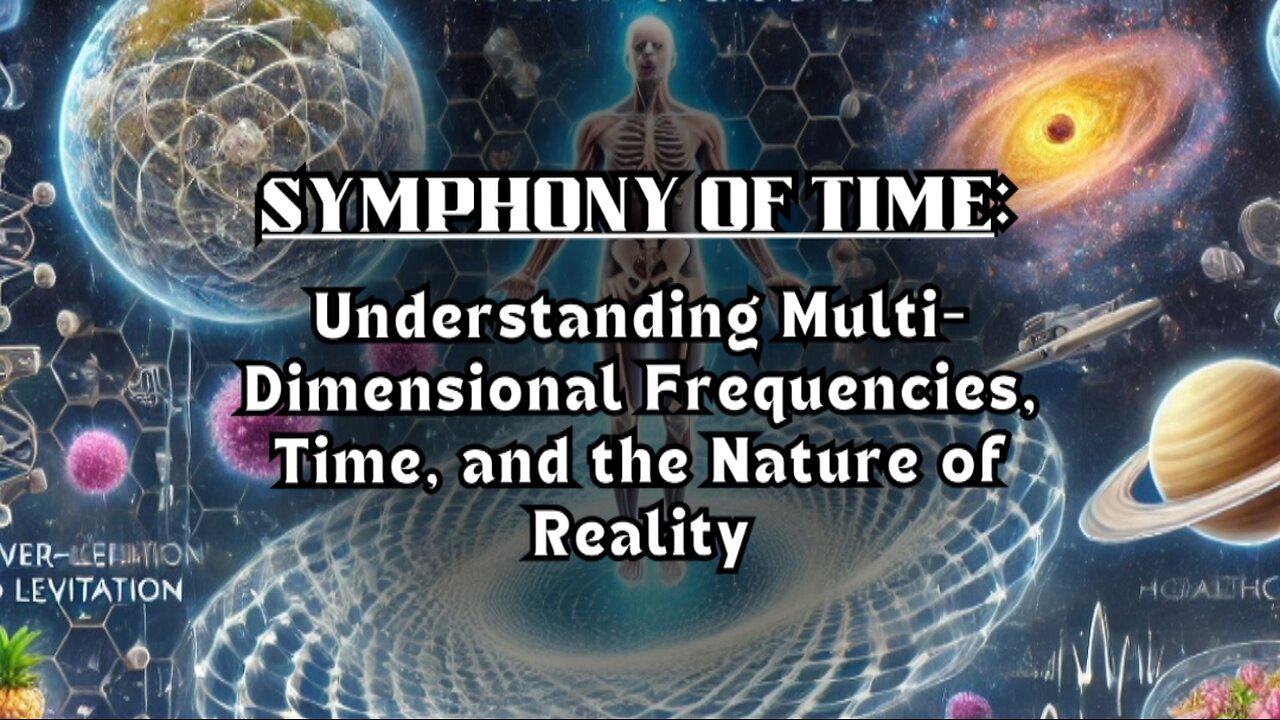Premium Only Content

Fi Theory: Understanding Multi-Dimensional Frequencies, Time, & the Nature of Reality
The Emergence of Time as the Root Mean Square (RMS) of Molecular Frequencies Modulated by Gravity: A Unified Approach Integrating String Theory and Loop Quantum Gravity
Abstract
This paper proposes a novel interpretation of time as an emergent property, conceptualized as the root mean square (RMS) of molecular vibrational frequencies. Time is viewed as being modulated by gravity, which acts as the zero point for these waveforms. This model integrates aspects of both string theory, which describes fundamental particles as vibrating strings, and loop quantum gravity (LQG), which seeks to quantize space-time. Additionally, the influence of dark matter and dark energy is considered as a modulating factor for molecular frequencies and space-time curvature. We develop a mathematical framework to explore how this emergent time model reconciles with current physical theories, followed by a discussion on its potential implications.
---
1. Introduction
Time has long been considered a fundamental dimension in both classical and quantum physics. In this paper, we revisit this concept by proposing that time, rather than being a fundamental constant, is an emergent property derived from the interactions of molecular frequencies. Drawing from both string theory and loop quantum gravity, we propose a model where time arises as the RMS of vibrational frequencies, modulated by gravitational fields. This approach allows for a new interpretation of how time, gravity, and quantum mechanics could be unified, while also addressing the influence of dark matter and dark energy.
---
2. Conceptual Foundation
2.1. Vibrational Nature of Particles in String Theory
In string theory, the fundamental particles are treated as vibrating one-dimensional strings, where different vibrational modes determine the properties of the particles. In this model:
\psi(\mathbf{x}, t) = A(\mathbf{x}) \sin(\omega t + \phi)
We extend this by suggesting that time itself emerges from the RMS of these vibrational frequencies across all particles or structures in a region of space-time:
\nu_{\text{RMS}} = \sqrt{\frac{1}{n} \sum_{i=1}^{n} \nu_i^2}
2.2. Gravity as a Modulation Factor
In general relativity, gravity is seen as the curvature of space-time, influenced by mass and energy. We propose that gravity also modulates the vibrational frequencies of molecular structures through a gravitational modulation factor , affecting the zero point of molecular waveforms:
\nu_i(\mathbf{x}, t) = \nu_{i,0} \cdot \alpha(\mathbf{x})
2.3. Integration with Loop Quantum Gravity
In loop quantum gravity, space-time is quantized and represented by discrete loops. We extend the RMS frequency approach to LQG by considering each quantum loop in space-time as vibrating with a frequency , leading to:
\nu_{\text{RMS}}^{\text{LQG}} = \sqrt{\frac{1}{N} \sum_{i=1}^{N} \nu_i^2}
---
3. Mathematical Framework
3.1. Time as a Function of RMS Frequencies
We define time as the inverse of the RMS frequency:
t(\nu_{\text{RMS}}) = \frac{1}{\nu_{\text{RMS}}}
3.2. Gravitational and Cosmological Modulation
To account for dark matter and dark energy influences, we introduce additional modulation factors:
\nu_i(\mathbf{x}, t) = \nu_{i,0} \cdot \alpha(\mathbf{x}) \cdot \beta(\mathbf{x}) \cdot \gamma(t)
: Dark energy’s cosmological expansion modulation factor.
The overall time in any given region of space-time is then:
t(\mathbf{x}, t) = \frac{1}{\sqrt{\frac{1}{N} \sum_{i=1}^{N} \left( \nu_{i,0} \cdot \alpha(\mathbf{x}) \cdot \beta(\mathbf{x}) \cdot \gamma(t) \right)^2 }}
---
4. Validation by Existing Models
4.1. String Theory
The concept of vibrational frequencies driving particle properties fits naturally into string theory. Our model extends this by associating time with these frequencies, thus proposing a direct link between vibrational modes and the passage of time. This doesn’t contradict string theory but introduces a new interpretation of how time might emerge from these fundamental oscillations.
4.2. Loop Quantum Gravity
The RMS vibrational model also aligns well with loop quantum gravity, where space-time is quantized into discrete loops. By associating each loop with a vibrational frequency, our model fits within the quantized framework of LQG and introduces a potential explanation for how time might emerge from these quantum loops.
4.3. General Relativity
Our treatment of gravity as a modulation factor is consistent with general relativity. The modulation of vibrational frequencies by the gravitational field explains time dilation near massive objects and offers an intuitive explanation for how gravity slows time.
4.4. Dark Matter and Dark Energy
While dark matter and dark energy remain largely unexplained in modern physics, our model provides a plausible framework in which these forces modulate molecular frequencies. Dark matter enhances gravitational effects, while dark energy, through cosmological expansion, influences the stretching of these frequencies over time.
---
5. Questions and Implications
Does this concept violate the laws of physics? No, the framework integrates seamlessly with string theory, loop quantum gravity, and general relativity. It offers a new perspective without contradicting established laws, especially those related to time dilation and space-time curvature.
How does this concept explain time’s arrow? Time's arrow could be seen as emerging from the increase in entropy, which is reflected in the changing vibrational frequencies of molecular structures over time. As frequencies evolve and change, they give rise to a perceived forward direction of time.
Could this model be tested? Experimentally, we could explore regions of extreme gravitational fields (e.g., near black holes) to observe how molecular frequencies shift and impact time perception. Additionally, investigating time dilation effects with more precision in controlled environments might yield insights into the vibrational nature of time.
---
6. Summary and Conclusion
This paper proposes a unified model in which time emerges as the root mean square (RMS) of molecular frequencies, modulated by gravity as the zero point of waveforms. This framework integrates string theory, where particles vibrate at specific frequencies, and loop quantum gravity, which quantizes space-time. The model is consistent with general relativity’s predictions about gravity and time dilation, while also offering a plausible explanation for dark matter and dark energy’s influence on time. Further exploration could reveal deeper insights into the fundamental nature of time, space, and matter.
---
7. References
(To be completed with actual literature and sources.)
[1] Green, M. B., Schwarz, J. H., & Witten, E. (1987). Superstring Theory. Cambridge University Press.
[2] Rovelli, C. (2004). Quantum Gravity. Cambridge University Press.
[3] Einstein, A. (1915). The Field Equations of Gravitation.
[4] Misner, C., Thorne, K., & Wheeler, J. (1973). Gravitation. W. H. Freeman and Company.
[5] Planck Collaboration. (2016). The Cosmic Energy Budget. Astrophysical Journal.
-
 34:12
34:12
inspirePlay
1 day ago $5.84 earned🏆 The Grid Championship 2024 – Cass Meyer vs. Kelly Rudney | Epic Battle for Long Drive Glory!
92.6K8 -
 17:50
17:50
BlackDiamondGunsandGear
17 hours ago $3.17 earnedTeach Me How to Build an AR-15
66.4K6 -
 9:11
9:11
Space Ice
1 day agoFatman - Greatest Santa Claus Fighting Hitmen Movie Of Mel Gibson's Career - Best Movie Ever
123K49 -
 42:38
42:38
Brewzle
1 day agoI Spent Too Much Money Bourbon Hunting In Kentucky
83.6K13 -
 1:15:30
1:15:30
World Nomac
1 day agoMY FIRST DAY BACK in Manila Philippines 🇵🇭
65K10 -
 13:19
13:19
Dr David Jockers
1 day ago $12.03 earned5 Dangerous Food Ingredients That Drive Inflammation
83.4K17 -
 1:05:13
1:05:13
FamilyFriendlyGaming
1 day ago $16.00 earnedCat Quest III Episode 8
132K3 -
 10:39
10:39
Cooking with Gruel
2 days agoMastering a Succulent London Broil
84.9K5 -
 22:15
22:15
barstoolsports
1 day agoWhite Elephant Sends Barstool Office into Chaos | VIVA TV
59.9K1 -
 3:30:40
3:30:40
MrNellyGB
23 hours ago🔴LIVE - GRINDING MARVEL RIVALS RANKED! | #RumbleTakeover #RumblePremium
41.2K1